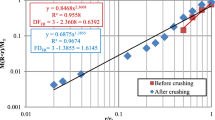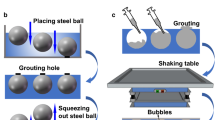Abstract
The micro-texture of the aggregates of a pavement layer has a direct influence on their resistance. Whatever the position of these aggregates in a pavement structure, they must withstand, during construction or during life, the stresses of attrition and impact. In this study, a series of mechanical tests (Proctor, Los-Angeles and Micro-Deval) are carried out on grains of local materials (limestone and shale), the degree of crushing of the grains has been quantified using the concept of fractal dimension. The fractal dimension was calculated for the different grains constituting the samples before and after each test, with the use of two two-dimensional 2D methods (Masses Method at the scale of a sample and the Box Counting Method at the scale of a grain) and a three-dimensional 3D method (Blanket on a grain scale) which is based on the use of the difference between erosion and dilation. We seek to determine from these methods the correlation between the two fractal dimensions, namely 2D and 3D and study the influence of different parameters on the mechanical characteristics of the materials chosen: the shape and size of the grains, the presence or absence of water, the stress intensity as well as the nature of the material. The results obtained show that the three-dimensional method has a positive effect on the description of the 3D microstructure of the surface of the grains subjected to the various mechanical tests.
























Similar content being viewed by others
Data Availability
The equipment on which we worked is equipment from the Tizi-Ouzou University laboratory.
References
AFNOR (1990a) Aggregates. Los Angeles test. NF P18–573
AFNOR (1990b) Aggregates. Micro-Deval attrition test. NF P18–572
AFNOR (1992a) Earthworks. Classification of materials for use in the construction of embankments and capping layers of road infrastructures. NF P 11–300
AFNOR (1992b) Soils: investigation and tests. Degradability coefficient of rocky material. NF P94–067
AFNOR (1992c) Soils: investigation and tests. Fragmentability coefficient of rocky material. NF P94–066
Arasan S, Yener E, Hattatoglu F, Akbulut S, Hinislioglu S (2010) The relationship between the fractal dimension and mechanical properties of asphalt concrete. Int J Civil Struct Eng 1(2):165–170
Arasan S, Akbulut S, Hasiloglu AS (2011) The Relationship between the fractal dimension and shape properties of particles. KSCE J Civ Eng 15(7):1219–1225
Ayed K, Chouicha K, Benaissa A, Semcha A, and Mekerta B (2003) Identification of compactness by the fractal dimension, Proceeding of the National Civil Engineering Seminar. Editions Dar El Gharb, ENSET Oran 28–29
Biggs S, Habgood M, Jameson GJ, Yan Yd (1998) The fractal analysis of aggregates formed via a bridging flocculation mechanism. Proceedings of the 26th Australian Chemical Engineering Conference, Chemeca 98, Port Douglas, Australia
Bouzeboudja A, Melbouci B (2016) Study of the evolution of the fractal dimension of a granular material’s grains during mechanical tests. Bull Eng Geol Env 75(2):821–839
Carpinteri A, Invernizzi S (2001) Influence of damage on the fractal properties of concrete subjected to pure tension. Mater Struct 34:605–611
Chappard D, Chennebault A, Moreau M, Legrand E, Audran M, Basle MF (2001) Texture analysis of X-ray radiographs is a more reliable descriptor of bone loss than mineral content in a rat model of localized disuse induced by the clostridium botulinum toxin. Bone 28:72–79
Chouicha K (2006) Fractal dimension and granular range as parameters for identifying granular mixes. Mater Struct 39:665–681
Folk RL (1959) Practical petrographic classification of limestones. Am Asso Petrol Geol Bull 43:1–38
Hammer KP (2005) Analysis of granular materials in Pennsylvania highways. Master of science thesis. University of Pittsburgh
Hillel D (1982) Introduction to soil physics. Academic Press Inc, New York, ISBN 9780123485 205, Hardback, p 392
Holtz RD, Kovacs WD (1991) Introduction à la géotechnique. Editions of the Ecole Polytechnique de Montreal, Montreal
Huang GH, Zhan WH (2002) Fractal property of soilparticle size distribution and its application. Acte Pedol Sin 39:490–497
Hyslip J, Vallejo L (1997) Fractal analysis of the roughness and size distribution of granular material. Eng Geol 48(3–4):231–244
Inaoka H, Ohno M (2003) New universality class of impact fragmentation. Fractals 11(4):369–376
Ji X, Chan SYN, Feng N (1997) Fractal model for simulating the space-filling process of cement hydrates and fractal dimensions of pore structure of cement-based materials. Cem Concr Res 27(11):1691–1699
Lange DA, Jennings HM, Shah SP (1993) Relationship between fracture surface roughness and fracture behaviour of cement paste and mortar. J Am Ceram Society 76(3):589–597
Leconte A, Thomas A (1992) Fractal character of granular mixes for highly compact concrete. Mater Struct 25:255–264
Legrain H (2006) Study of the influence of roughness on fluid flow in rock cracks. Thesis, Polytechnic Faculty of Mons
Mandelbrot B (1983) The fractal geometry of nature. Edition W.II. Freeman, San Francisco, p 461
MATLAB R2009b
Meng B (1996) Determination and interpretation of fractal properties of the sandstone pore system. Mater Struct 29:195–205
Peleg S, Naor J, Hartley R, Avnir D (1984) Multiple resolution texture analysis and classification. IEEE Trans, Pattern Anal Mach Intell, PAMI 6:518–523
Perfect E (1997) Fractal models for the fragmentation of rocks and soils: a review. Eng Geol 48:185–198
Perfect E, Kay BD (1991) Fractal theory applied to soil aggregation. Soil Sci Soc Am J 55(6):1552–1558
Perrier E, Bird N (2002) Modelling soil fragmentation: the pore solid fractal approach. Soil Tillage Res 64:91–99
Perrier E, Bird N, Rieu M (1999) Generalizing the fractal model of soil structure: the pore –solid fractal approach. Geoderma 88:137–164
Ramamurthy T (1969) Crushing phenomena in granular soils. J Indian Nat Soc Soil Mech Found Eng 8(1):67–86
Rieu M, Perrier E (1997) Fractal models of fragmented and aggregated soils. In: Baveye P, Parlange JY, Stewart BA (eds) Fractal in soil sciences. CRC Press LLC, pp 169–202
Russe D, Hanson J, Ott E (1980) Dimension of strange attractors. Phys Rev Lett 45:1175–1178
Secrieru C, (2009) Applications de l’analyse fractale dans le cas de ruptures dynamiques. Doctoral Thesis Mechanics and Materials, Polytechnic University of Timisoara, Romania
Soulié F (2005) Cohésion par capillarité et comportement mécanique de milieux granulaires. Doctoral thesis, University of Montpellier II
Tang P, Raper JA (2002) Modelling the settling behaviour of fractal aggregates, a review. Powder Technol 123(2–3):114–125
Taud H, Parrot J-F (2005) Measurement of DEM roughness using the local fractal dimension. Géomorphologie: Relief Processus Environ 11(4):327–338
Troadec JP, Guyon E (1994) Du Sac de Billes au tas de Sables. Editions Odile JACOB, Paris
Turcotte DL (1997) Fractals and chaos in geology and geophysics, 2nd edn. Cambridge University Press
Tyler SW, Wheatcraft SW (1992) Fractal scaling of soil particle-size distributions: analysis and limitations. Soil Sci Soc Am J 56:362–369
Wang C, Zhu H (2016) Combination of Kriging methods and multi-fractal analysis for estimating spatial distribution of geotechnical parameters. Bull Eng Geol Environ 75:413–423
Wang X, Li M-H, Lui S, Lui G (2006) Fractal characteristics of soils under different land-use patterns in the arid and semiarid regions of the Tibetan plateau China. Geoderma 134(1–2):56–61
Xu YF (2003) Surface fractal dimension of swelling clay minerals. Fractals 11(4):353–362
Xu YF, Sun DA (2005) Correlation of surface fractal dimension with frictional angle at critical state of sands. Geotechnique 55(9):691–695
Yang R, Xu Z (2007) Relationship between fractal dimension and road performance of dense-gradation asphalt mixture. Tumu Gongcheng Xuebao/china Civil Eng J 40(3):98–103
Funding
There is no funding, this work is part of a research project of the University of Tizi-Ouzou.
Author information
Authors and Affiliations
Contributions
The authors welcome the submission of this work and they fully agree with the publication of this article.
Corresponding author
Ethics declarations
Conflict of interest
This work once published can be made available to researchers. There are no conflicts of interest.
Code Availability
The software used is available at the laboratory of the University of Tizi Ouzou.
Additional information
Publisher's Note
Springer Nature remains neutral with regard to jurisdictional claims in published maps and institutional affiliations.
Rights and permissions
About this article
Cite this article
Bouzeboudja, H., Melbouci, B. & Bouzeboudja, A. Experimental Study of Crushed Granular Materials by the Notion of Fractal Dimension in 2D and 3D. Geotech Geol Eng 40, 2009–2031 (2022). https://doi.org/10.1007/s10706-021-02007-3
Received:
Accepted:
Published:
Issue Date:
DOI: https://doi.org/10.1007/s10706-021-02007-3




